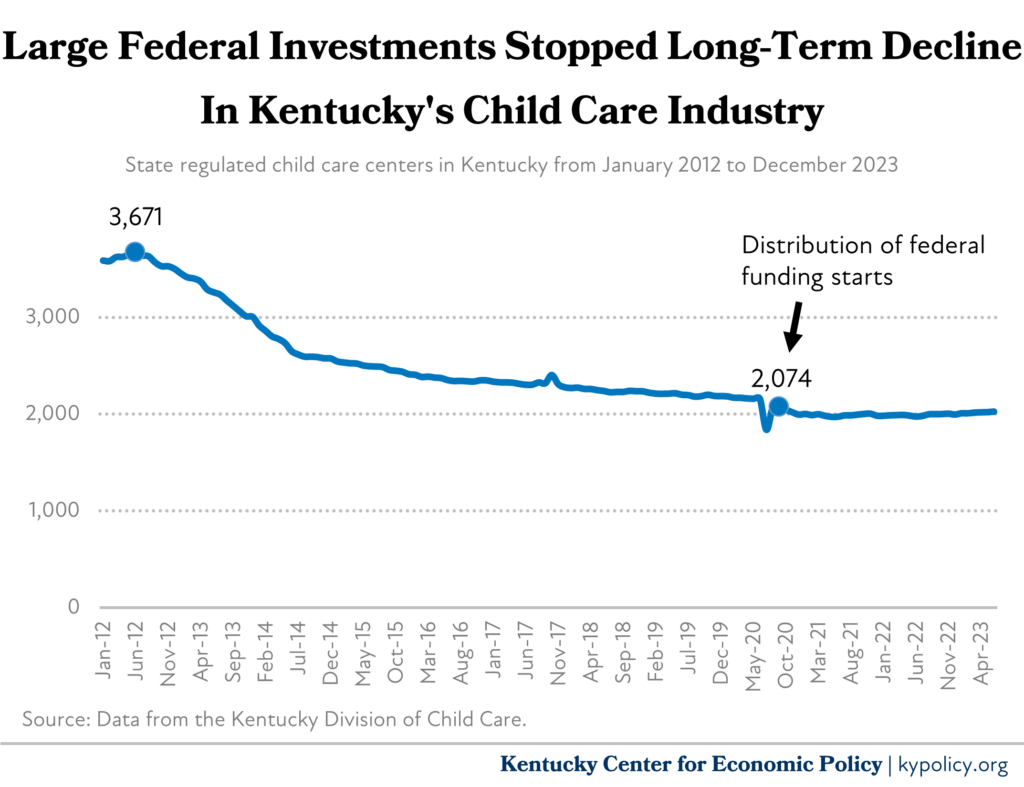The American Rescue Plan Act (ARPA) was a lifeline for child care in Kentucky, providing substantial resources that prevented a continued decline in this vital sector. Child care centers used this crucial federal money to improve wages, tuition and staffing levels, improve the quality of care and help sustain this essential industry. Kentucky’s child care providers had been closing their doors for nearly a decade, but the federal funding brought that decline to a halt by the middle of 2020 and has sustained approximately 2,000 providers since that time.

However, by September of this year, $330 million in annual federal funding that supported these improvements will end. Without action by the General Assembly to make up for the loss of funds, Kentucky’s child care sector faces destabilization, resulting in more center closures and job loss and fueling a growing crisis in access and affordability of care.
ARPA funding had two different uses, funding many improvements
Of the ARPA child care funds sent to Kentucky, 38% bolstered the Child Care and Development Block Grant (CCDBG), which Kentucky receives to help cover the cost of the Child Care Assistance Program (CCAP) and other child care needs, and 62% went for stabilization grants to child care centers. It would cost $330 million annually to replace these supports.
The added CCDBG funding is going to several different supports for CCAP and the child care workforce, and require approximately $130 million annually in state funds to replace:
- $40 million annually goes to increase the reimbursement rate for child care providers accepting children covered by CCAP so that payments met the 80th percentile of market rates.
- $40 million is for improved CCAP eligibility by switching from 160% of the federal poverty level (FPL), to 85% of State Median Income (SMI) by household size. For example, a household of 4 at 160% FPL in 2023 had an annual income of $48,000, but a household of 4 at 85% SMI was $74,424. As of June 2023, nearly 7,800 children had benefitted from this increase.
- $20 million is for an enrollment-based reimbursement for CCAP as opposed to an attendance-based reimbursement. This major improvement was long sought by child care providers as it helps provide stability and consistency in paying staff. Whether or not a child in CCAP has to miss a day for illness, a doctor’s appointment or some other reason, centers still have to pay teachers and other staff. Ensuring CCAP paid for the spot, and not the daily presence of the child, has made it much more financially feasible to accept children covered by CCAP.
- $30 million is going to allow employees of child care centers to use CCAP for their own children. This policy has bolstered an otherwise low-paying workforce (averaging $12 per hour), and helped improve the financial stability of child care centers – and is something for which Kentucky has gained national praise.
- Other uses of these funds have included paying start-up grants to 102 home and center-based child care providers, providing nearly 1,100 scholarships to child care workers to get early childhood education certificates and degrees (including 87 masters degrees), providing up to $10,000 in facility repair grants and helping centers upgrade their billing and enrollment technology.
This source of funding expires in September 2024.
The second source of funds provided nine separate stabilization grants directly to child care centers at approximately $50 million per quarter, based on the number of children enrolled in the center and in a form that encourages higher wages for these low-wage jobs. The average payment has been $33,000 per center, per quarter. Because of the restrictions in ARPA, only centers that were operating as of March 2021 and after were eligible for the payments, so by the time payments ended in 2023, roughly a quarter of centers were left out of the stabilization grants. This federal source of funding expired in September of 2023, with one additional, state-funded stabilization payment made in December 2023.
Combined, these two funding streams have provided an annual $330 million in funding.
State funding at current levels is completely insufficient
Recent state appropriations for the entire Division of Child Care have been a fraction of what Kentucky is about to lose in federal funds. The 2024 General Fund appropriation for child care was $40.5 million, of which $15 million was for a pilot project that matched employer contributions to their employee’s child care costs. At current levels, the child care industry is set to lose all $330 million in annual assistance to the industry.
The proposed House budget provides $30 million in 2025 and $40 million in 2026 only to keep reimbursement rates at the 80th percentile of market rates. This means that the proposed budget allows up to $290 million each year to lapse, putting the child care industry into a severely destabilized financial position.
Kentucky can afford to make a big investment in child care in this budget
Kentucky’s surplus is expected to total $1.9 billion by the end of this fiscal year. In fact, the revenues above spending have averaged over $1 billion for the past three fiscal years, meaning there is plenty of fiscal capacity for new, recurring investments in Kentucky. This is in addition to the current Budget Reserve Trust Fund balance of $3.7 billion.
If the General Assembly does not act quickly, and significantly, Kentucky will lose the $130 million that supports income eligibility for CCAP, improved reimbursement rates and methods, child care worker eligibility for assistance, and centers will have $200 million less in dependable revenue from the stabilization payments. Without state resources to preserve some or all of these policies, the result is that tuition will increase, making it even more difficult for families to afford care; staff will be laid off, have their pay cut or leave, reducing the capacity of centers to accept children; and centers will close their doors, expanding an already untenable child care desert across Kentucky.
$330 million is a significant fiscal cliff that calls for significant state investment just to hold Kentucky’s child care sector harmless, and the General Assembly has the means to do it.




